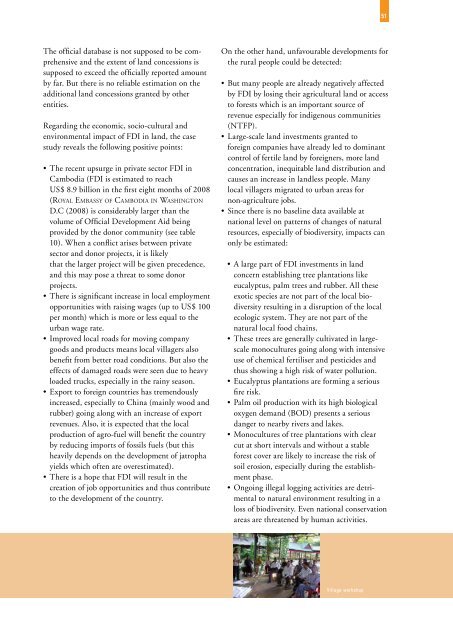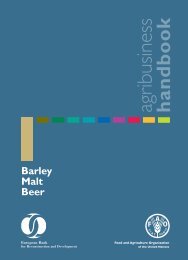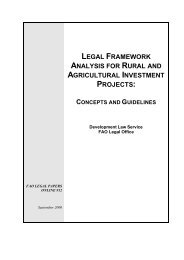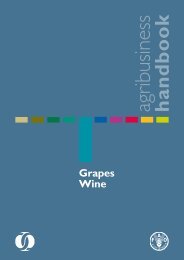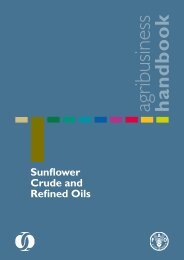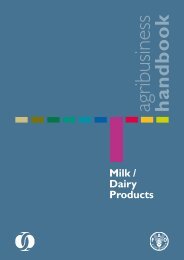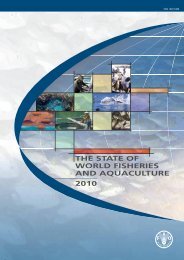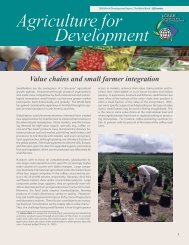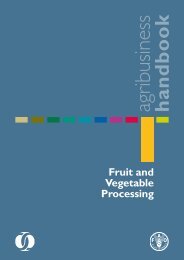Foreign Direct Investment (FDI) in Land in developing countries
Foreign Direct Investment (FDI) in Land in developing countries
Foreign Direct Investment (FDI) in Land in developing countries
- No tags were found...
You also want an ePaper? Increase the reach of your titles
YUMPU automatically turns print PDFs into web optimized ePapers that Google loves.
51The official database is not supposed to be comprehensiveand the extent of land concessions issupposed to exceed the officially reported amountby far. But there is no reliable estimation on theadditional land concessions granted by otherentities.Regard<strong>in</strong>g the economic, socio-cultural andenvironmental impact of <strong>FDI</strong> <strong>in</strong> land, the casestudy reveals the follow<strong>in</strong>g positive po<strong>in</strong>ts:• The recent upsurge <strong>in</strong> private sector <strong>FDI</strong> <strong>in</strong>Cambodia (<strong>FDI</strong> is estimated to reachUS$ 8.9 billion <strong>in</strong> the first eight months of 2008(Royal Embassy of Cambodia <strong>in</strong> Wash<strong>in</strong>gtonD.C (2008) is considerably larger than thevolume of Official Development Aid be<strong>in</strong>gprovided by the donor community (see table10). When a conflict arises between privatesector and donor projects, it is likelythat the larger project will be given precedence,and this may pose a threat to some donorprojects.• There is significant <strong>in</strong>crease <strong>in</strong> local employmentopportunities with rais<strong>in</strong>g wages (up to US$ 100per month) which is more or less equal to theurban wage rate.• Improved local roads for mov<strong>in</strong>g companygoods and products means local villagers alsobenefit from better road conditions. But also theeffects of damaged roads were seen due to heavyloaded trucks, especially <strong>in</strong> the ra<strong>in</strong>y season.• Export to foreign <strong>countries</strong> has tremendously<strong>in</strong>creased, especially to Ch<strong>in</strong>a (ma<strong>in</strong>ly wood andrubber) go<strong>in</strong>g along with an <strong>in</strong>crease of exportrevenues. Also, it is expected that the localproduction of agro-fuel will benefit the countryby reduc<strong>in</strong>g imports of fossils fuels (but thisheavily depends on the development of jatrophayields which often are overestimated).• There is a hope that <strong>FDI</strong> will result <strong>in</strong> thecreation of job opportunities and thus contributeto the development of the country.On the other hand, unfavourable developments forthe rural people could be detected:• But many people are already negatively affectedby <strong>FDI</strong> by los<strong>in</strong>g their agricultural land or accessto forests which is an important source ofrevenue especially for <strong>in</strong>digenous communities(NTFP).• Large-scale land <strong>in</strong>vestments granted toforeign companies have already led to dom<strong>in</strong>antcontrol of fertile land by foreigners, more landconcentration, <strong>in</strong>equitable land distribution andcauses an <strong>in</strong>crease <strong>in</strong> landless people. Manylocal villagers migrated to urban areas fornon-agriculture jobs.• S<strong>in</strong>ce there is no basel<strong>in</strong>e data available atnational level on patterns of changes of naturalresources, especially of biodiversity, impacts canonly be estimated:• A large part of <strong>FDI</strong> <strong>in</strong>vestments <strong>in</strong> landconcern establish<strong>in</strong>g tree plantations likeeucalyptus, palm trees and rubber. All theseexotic species are not part of the local biodiversityresult<strong>in</strong>g <strong>in</strong> a disruption of the localecologic system. They are not part of thenatural local food cha<strong>in</strong>s.• These trees are generally cultivated <strong>in</strong> largescalemonocultures go<strong>in</strong>g along with <strong>in</strong>tensiveuse of chemical fertiliser and pesticides andthus show<strong>in</strong>g a high risk of water pollution.• Eucalyptus plantations are form<strong>in</strong>g a seriousfire risk.• Palm oil production with its high biologicaloxygen demand (BOD) presents a seriousdanger to nearby rivers and lakes.• Monocultures of tree plantations with clearcut at short <strong>in</strong>tervals and without a stableforest cover are likely to <strong>in</strong>crease the risk ofsoil erosion, especially dur<strong>in</strong>g the establishmentphase.• Ongo<strong>in</strong>g illegal logg<strong>in</strong>g activities are detrimentalto natural environment result<strong>in</strong>g <strong>in</strong> aloss of biodiversity. Even national conservationareas are threatened by human activities.Village workshop


